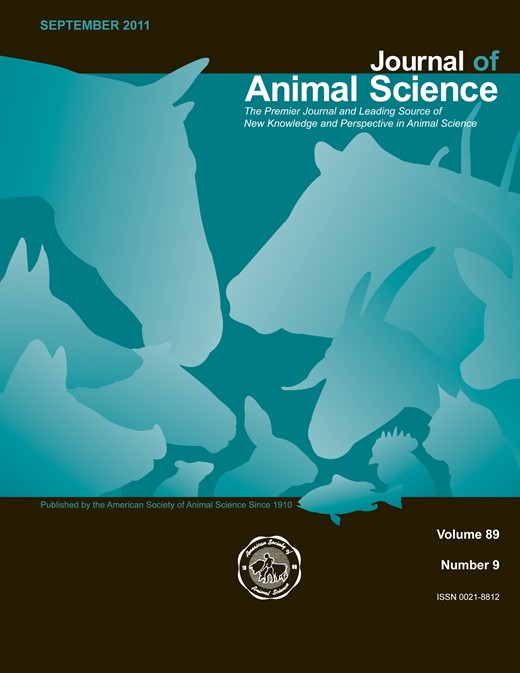-
Views
-
Cite
Cite
M. L. Sullivan, A. J. Cawdell-Smith, T. L. Mader, J. B. Gaughan, Effect of shade area on performance and welfare of short-fed feedlot cattle, Journal of Animal Science, Volume 89, Issue 9, September 2011, Pages 2911–2925, https://doi.org/10.2527/jas.2010-3152
Close - Share Icon Share
ABSTRACT
One hundred twenty-six Black Angus yearling heifers were used in a 119-d study to assess the effect of shade allocation (0, 2.0, 3.3, or 4.7 m2/animal) on the performance and welfare of feedlot cattle. Shade treatments were replicated 4 times and the no-shade treatment was replicated twice. Shade was provided by 70% solar block shade cloth, attached to a 4-m-high frame with a north-south orientation. Cattle were randomly allocated to a pen (9/pen; 19.2 m2/animal) within treatment. Performance was assessed using DMI, G:F, ADG, HCW, dressing percentage, and rump fat depth. Climatic data (ambient and black globe temperature, solar radiation, wind speed, relative humidity, and rainfall) were recorded. From these data, the heat load index (HLI) was calculated. When the daily maximum HLI (HLIMax) was <86, individual panting score (0 = no panting; 4 = open mouth, tongue extended), animal location (eating, drinking, under shade), and animal posture (standing or lying) were collected at 0600, 1200, and 1800 h. When HLIMax was ≥86, these data were collected every 2 h between 0600 and 1800 h. Feed intake was recorded weekly and water intake was recorded daily on a pen basis. When HLIMax was ≥86, mean panting score (MPS: mean of animals within treatment) was greatest (1.02; P < 0.001) for unshaded cattle compared with cattle in the shade treatments, which were similar (0.82; P = 0.81). During heat waves, the MPS of unshaded cattle was greater (2.66; P < 0.001) than that for shaded cattle. The MPS of cattle in the 2.0 m2/animal treatment (2.43 ± 0.13) was greater (P < 0.001) than that of cattle in the 3.3 (2.11 ± 0.13) and 4.7 m2/animal (2.03 ± 0.13) treatments. The MPS of cattle in the 3.3 and 4.7 m2/animal treatments were similar (P = 0.09). Number standing was similar (P = 0.98) between unshaded and shaded at 2.0 m2/animal treatments with 4.75 and 4.76 animals/pen, respectively. Fewer (P < 0.0001) were standing in the 3.3 (4.19 animals/pen) and 4.7 m2/animal (4.06 animals/pen) treatments. Fewer (P = 0.004) cattle were under the shade at 2.0 m2/animal (47.1%) compared with the number under the shade at 3.3 (53.7%) and 4.7 m2/animal (53.6%). Unshaded cattle had the smallest (0.085 ± 0.006) G:F ratio (P = 0.01), followed by cattle shaded at 4.7 m2/animal (0.104 ± 0.006; P ≤ 0.001). There was no difference (P = 0.12) between the 2.0 and 3.3 m2/animal treatments. There were no differences (P > 0.10) for final BW, HCW, dressing percentage, and rump fat depth. Cattle with access to shade had smaller panting scores, which suggests improved welfare, and had better feed efficiency. Shade reduced the intensity of the heat load but did not fully remove the effect of heat.





